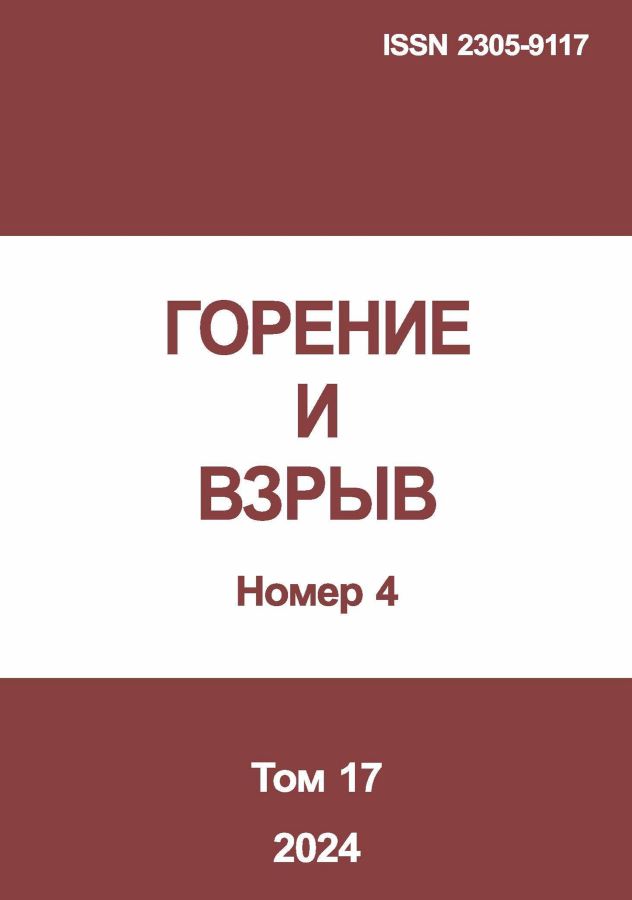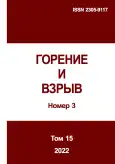Том 15, № 3 (2022)
К стационарной теории зажигания газов нагретым телом
Аннотация
Стационарная теория зажигания накаленной плоской поверхностью, сформулированная Я. Б. Зельдовичем в 1939 г., сыграла пионерскую роль в успешном развитии исследований по воспламенению различных горючих материалов. Аналитическое решение, полученное позднее для цилиндрической поверхности, открыло возможность для сравнения с экспериментальными данными. В работах, выполненных Филипповым с соавторами, было обнаружено расхождение между опытами по зажиганию метановоздушных смесей нагретыми проволочками и аналитическим решением. Опираясь на это расхождение, Филиппов с соавторами высказали сомнение в корректности модели. Однако указанное расхождение может быть вызвано тем, что эксперимент, использованный для сравнения с моделью, не в полной мере удовлетворяет тем ограничениям, которые вытекают из упрощающих предположений, сделанных при формулировке модели. Эти предположения и следующие из них ограничения анализируются в данной работе применительно к опытам Кумагаи по зажиганию метановоздушной смеси. Ключевые допущения стационарной модели зажигания: упрощенное описание кинетики химического тепловыделения с использованием глобальной одностадийной реакции Аррениусова типа без учета выгорания; условие, что толщина реакционной зоны должна быть существенно меньше толщины пограничного слоя; цилиндрическая симметрия теплового поля вокруг нагретого тела. Из анализа кинетики тепловыделения получено численное решение для двух нестационарных задач о зажигании газа нагретым телом и о самовоспламенении газа в проточном реакторе идеального вытеснения с детальной кинетикой реакций. Решение показало, что зависимость скорости тепловыделения от температуры, построенная для конкретных вариантов расчетов, имеет сложную форму, которую даже приближенно невозможно описать, используя закон тепловыделения в форме Аррениуса. Тем не менее оказалось, что критические числа Нуссельта, разграничивающие область зажигания и область стационарных температурных профилей, которые были рассчитаны по формулам аналитической модели при соответствующей процедуре калибровки характеристик тепловыделения, находятся в неплохом согласии с экспериментальными данными во всем диапазоне изменения диаметров и температур нагрева проволочки и скоростей газового потока. Также хорошее согласие с экспериментом и аналитической моделью по критическим условиям зажигания получено в расчетах по нестационарной модели зажигания, несмотря на заметные различия по скорости тепловыделения в зависимости от температуры. Условие малой толщины зоны реакции по отношению к размеру пограничного слоя, в целом, выполняется достаточно строго, хотя при высоких скоростях газового потока (на уровне 10 м/с) строгость условия становится недостаточной, чтобы исключить вклад конвективной составляющей в переносе тепла в зоне реакции. Из-за срыва пограничного слоя и формирования вихрей на поверхности нагретого тела вблизи азимутального угла 90 появляются участки с пониженной теплоотдачей, величина которой может быть заметно меньше средней величины. Именно на этих участках поверхности нагретого тела создаются условия, благоприятные для зажигания. Если провести корректировку экспериментальных данных путем соответствующего снижения критических чисел Нуссельта в указанных опытах, то это ослабит зависимость критического числа Нуссельта от диаметра проволочки, наблюдаемую в эксперименте, приближая ее к примерно пропорциональной зависимости, которая следует из аналитического решения.
 3-17
3-17


Исследование неустойчивостей плазменно-стабилизированного сверхзвукового горения
Аннотация
Рассматриваются два типа неустойчивостей сверхзвукового () горения при плазменной стабилизации, идентифицированных в реагирующем потоке при прямом впрыске газообразного углеводородного топлива: глобальная неустойчивость, развивающаяся вследствие взаимосвязи в системе поток–горение–плазма, и высокочастотная неустойчивость термоакустической природы. Эксперименты проводили на сверхзвуковой установке SBR-50 при следующих параметрах: давление бар, температура К, массовый расход топлива г/с. Диагностика включала измерение давления, скоростную камеру с опцией спектрального фильтра, теневую визуализацию и спектроскопические наблюдения. Глобальная неустойчивость развивается с характерным временем около 10 мс и связана с взаимодействием зоны отрыва потока, где реализуется горение, с отраженной ударной волной и электрическим разрядом. Показано, что эта неустойчивость может эффективно подавляться с помощью управления мощностью электрического разряда. Термоакустическая неустойчивость развивается с характерным временем мс. Анализ данных по давлению выявил наличие резонансной акустической волны в зоне горения, возникающей в области между инжекторами топлива и диффузором тестовой секции.
 18-27
18-27


Моделирование взаимодействия гомогенной водородно-воздушной детонации с пористым фильтром
Аннотация
Проведены расчеты взаимодействия ячеистой детонационной волны с инертным пористым фильтром на основе разработанной физико-математической модели механики гетерогенной среды, учитывающей детальную химическую кинетику химических реакций в газовой фазе. Под инертным пористым фильтром понимается неподвижная решетка инертных частиц. Выявлены следующие режимы течения: распространение ослабленной ячеистой детонационной волны со скоростями меньше скорости Чепмена–Жуге и срыв детонации с разрушением ячеистой структуры. Рассчитаны критические объемные концентрации частиц фильтра, соответствующие режиму срыва детонации. Рассчитаны зависимости нормированной скорости детонационной волны и размера детонационной ячейки от объемной концентрации частиц в фильтрах. Определены концентрационные пределы детонации (критические объемные концентрации частиц, приводящие к срыву детонации) в фильтрах частиц диаметром 50, 100 и 200 мкм. Рассчитаны зависимости нормированной скорости детонационной волны и размеров детонационной ячейки от объемной концентрации и диаметра частиц в фильтрах.
 28-34
28-34


Характеристики микровзрывного диспергирования частиц гелеобразного топлива при зажигании в высокотемпературной воздушной среде
Аннотация
Выполнено экспериментальное исследование зажигания и горения группы составов гелеобразных топлив, в том числе с добавлением мелкодисперсных частиц металлов и неметаллов, в условиях диспергирования капли расплава топлива при интенсивном нагреве в высокотемпературной среде неподвижного газообразного окислителя. Группа упруго деформируемых составов гелеобразных топлив приготовлена на основе маслонаполненных криогелей с добавлением 30%(масс.) мелкодисперсных частиц (углеродистых, Si, Cu) и без них. В условиях лучистого нагрева при температурах окислителя 600–1000 °C установлено устойчивое зажигание топлива при протекании процесса диспергирования, оказывающего положительное влияние на интенсивность выгорания горючих компонентов топлива. Для исследовавшихся топливных составов установлены времена задержки зажигания частиц начальной массой 10 мг и средние скорости движения мелкодисперсных фрагментов, разлетающихся при диспергировании капель расплава топлива.
 35-45
35-45


Сравнение двух способов определения тяговых характеристик модельных воздушно-реактивных двигателей
Аннотация
При исследовании процессов горения в камерах сгорания воздушно-реактивных двигателей (ВРД) основное внимание уделяется определению их тяговых характеристик. Основным способом определения тяговых характеристик является непосредственное измерение тяги, создаваемой камерой сгорания или зарядом твердого топлива. Другим способом определения тяговых характеристик является определение импульса струи, истекающей через звуковое сопло по известным параметрам потока на срезе сопла (давление, температура, состав газа). В зависимости от поставленной задачи удобно использовать один из указанных способов. В данной работе проводится сравнение результатов определения тяговых характеристик модельной камеры сгорания двумя способами в условиях одного эксперимента.
 46-50
46-50


Особенности спонтанной конденсации оксида бора в плоских и осесимметричных соплах: численный анализ
Аннотация
Разработана модель спонтанной конденсации паров оксида бора в химически реагирующих газовых смесях, базирующаяся на классической теории нуклеации (КТН) и односкоростном и однотемпературном приближении для уравнений движения двухфазной смеси. Модель учитывает процессы нуклеации, конденсационного роста капель, их коагуляцию и газофазные химические реакции. Выполнено численное исследование спонтанной конденсации паров оксида бора в плоских и осесимметричных соплах. Показано, что в плоских соплах с небольшой степенью расширения процесс конденсации протекает по типичному сценарию: образование скачка конденсации за горлом сопла и конденсационный рост капель ниже по течению за скачком. В геометрически подобных плоских соплах c небольшой степенью расширения положение скачка конденсации не зависит от линейных размеров сопла. Важной особенностью спонтанной конденсации в соплах с небольшой степенью расширения является равновесие пара и конденсата в выходном сечении сопла. В соплах с большой степенью расширения фазовое равновесие не достигается. Степень отклонения от равновесия в соплах такого типа тем значительнее, чем больше угол раскрытия сверхзвуковой части сопла.
 51-62
51-62


Моделирование взаимодействия гетерогенной детонации с пористыми вставками
Аннотация
Предложена физико-математическая модель в одномерной и двумерной постановке, описывающая процесс взаимодействия гетерогенной детонационной волны с полубесконечной пористой вставкой. Выявлены основные режимы распространения детонации: распространение затухающей ячеистой детонационной волны со скоростями меньше скорости Чепмена–Жуге при концентрациях цилиндров меньше критической и срыв детонации с разрушением ячеистой структуры при концентрациях цилиндров, равных или превышающих критическую. Построена карта режимов распространения гетерогенной детонации стехиометрической смеси частиц алюминия диаметром 1, 2 и 3,5 мкм в кислороде в пористой зоне с цилиндрами диаметром 100 мкм. Получены критические условия распространения гетерогенной детонации в стехиометрической смеси 1, 2 и 3,5 мкм. Показано, что с увеличением размера горящих частиц от 1 до 3,5 мкм критическая объемная концентрация уменьшается. Результаты сравнения одномерных и двумерных расчетов показывают, что они похожи друг на друга.
 63-70
63-70


Влияние объема реактора на автотермическую конверсию природного газа и аллотермическую газификацию органических отходов ультраперегретым паром
Аннотация
Технология импульсно-детонационной пушки (ИДП) применена для автотермической высокотемпературной конверсии природного газа и аллотермической бескислородной газификации жидких/твердых органических отходов ультраперегретым водяным паром (УПП) при атмосферном давлении с использованием двух проточных реакторов существенно разного объема: 100 и 40 л. Импульсно-детонационная пушка работала с частотой 1 Гц на смеси природного газа с кислородом. В качестве жидких и твердых органических отходов использовались отработанное машинное масло и древесные опилки влажностью от 10 до 30 %(вес.). Ожидалось, что уменьшение объема проточного реактора от 100 до 40 л, с одной стороны, не должно повлиять на конверсию природного газа, а с другой стороны, могло привести к повышению температуры газификации в проточном реакторе и, соответственно, к повышению качества получаемого синтез-газа (H2 + CO). Как и ожидалось, в ИДП была достигнута полная конверсия природного газа в синтез-газ с объемными отношениями Н2/СО и СО2/СО, равными 1,25 и 0,25, которые не зависели от объема реактора. Жидкие и твердые отходы конвертировались в проточных реакторах в газ, содержащий Н2, СО, СН4 и CO2. Установившиеся значения отношений H2/CO и CO2/CO в синтез-газе, полученном из отработанного машинного масла, составили 0,8 и 0,5 в 100-литровом реакторе и 0,9 и 0,2 в 40-литровом реакторе соответственно, что указывает на ожидаемое повышение качества синтез-газа. При этом максимальный массовый расход сырья в 40-литровом реакторе увеличился более чем в 4 раза по сравнению со 100-литровым реактором. Установившиеся значения отношений Н2/СО и СО2/СО в синтез-газе, полученном из порции древесных опилок фиксированной массы (2 кг), составили 0,5 и 0,8 для обоих реакторов, а время газификации в обоих реакторах составило около 5–7 мин. Показано, что измеренные объемные доли H2, СО и CO2 в синтез-газе, полученном как при автотермической высокотемпературной конверсии природного газа, так и при аллотермической бескислородной газификации жидких/твердых органических отходов в среде УПП при атмосферном давлении и Гц, почти не зависели от исходного сырья и объема реактора, что связано с высокими значениями локальной мгновенной температуры газификации.
 71-87
71-87


О механизме аэроакустического инициирования пульсирующего квазидетонационного горения в эжекторном пульсирующем воздушно-реактивном двигателе
Аннотация
Рассматривается конструкция пульсирующего воздушно-реактивного двигателя (ПуВРД), в которой реализуется новый механизм перехода от режима дефлаграционного горения к режиму, близкому к детонационному горению или квазидетонационному. Установлено, что возможность такого перехода обеспечивает специальная конструкция газохода, имеющая двойной излом, который приводит к формированию специфичной вихревой структуры внутреннего течения, а это позволяет методами акустической настройки газохода выйти на подобные режимы горения.
 88-99
88-99


Тепловой взрыв энергетического композиционного материала, пластифицированного нитроэфирами
Аннотация
Экспериментально определены временные интервалы задержки теплового взрыва смесевого энергетического материала типа NEPE на образцах в форме цилиндров диаметром и высотой 4 мм, запрессованных в герметичные стальные оболочки с плотностью заполнения, близкой к теоретической. Опыты проводили в изопериболических условиях в диапазоне температур от 110 до 140 С. Приведено сравнение полученных экспериментальных значений с рассчитанными по системе уравнений теплопроводности и кинетики с применением кинетических характеристик, полученных методом дифференциальной сканирующей калориметрии (ДСК). Показано, что результаты экспериментов и численных расчетов согласуются наилучшим образом при использовании формально-кинетического уравнения разветвленной цепной реакции.
 100-107
100-107


Взрывчатые свойства прессованных составов на основе перхлората аммония и севилена с добавкой алюминия
Аннотация
Ранее было обнаружено, что стехиометрическая смесь перхлората аммония и севилена (термопластичный клей, сополимер этилена и винилацетата) с добавкой 20% порошкообразного алюминия микронного размера в прессованных плотных образцах дает взрыв при инициировании электрическим высоковольтным разрядом. Показано, что использование удаляемого растворителя (ацетона) в процессе приготовления смеси существенно облегчает высоковольтное инициирование взрыва: взрывы обнаружены на образцах из смеси с 10%-ной добавкой алюминия, а в случае смесей с 20%-ной добавкой алюминия значительно снижается пороговое напряжение разряда, при котором инициируется взрыв. При замене алюминия на порошки меди и цинка близкой дисперсности взрывы отсутствовали. Это подтверждает, что именно алюминий обладает набором качеств, необходимых для высоковольтного инициирования взрыва. Определена минимальная энергия разряда, необходимая для высоковольтного инициирования взрыва. Получена зависимость минимальной энергии от способа приготовления смесей (с использованием или без растворителя) и количества алюминия, введенного в смесь. Уникальное сочетание низкой чувствительности смесей перхлората аммония с севиленом и 20% алюминия к удару, которая была получена в испытании на копре, высокой восприимчивости к взрыву при высоковольтном разряде и прекрасной адгезии севилена к дисперсным компонентам смеси в прессованных образцах открывает возможности для использования этого состава в устройствах инициирования.
 108-116
108-116


Энергии перестройки аминильных радикалов
Аннотация
Для расчета энергии перестройки метиламинильных радикалов использованы энтальпии образования в газовой фазе соответствующих соединений и энтальпии образования аминильных радикалов. Специфика этих соединений заключается в том, что каждый радикал можно исследовать через производные водорода и через метилпроизводные, т. е. определить энергии перестройки радикалов через независимые энтальпии образования соединений в газовой фазе и определить средние значения. Полученные величины позволили определить энергии диссоциации связей и средние термохимические энергии связей (С–Н и С–N) в производных метиламинов.
 117-120
117-120


История. Памятные даты. События
Борис Григорьевич Лобойко
 121-125
121-125












